Pasta primavera loaded with fresh veggies tossed in a light, garlicky, lemony cream sauce – on your table in 30 minutes!
Pasta primavera is the tastiest way to eat all your veggies! It’s light, refreshing, vibrant, aromatic and just creamy enough to hypnotize even your pickiest eater into seconds and thirds. This pasta primavera recipe is loaded with broccoli, squash, zucchini, asparagus, bell peppers, tomatoes and peas BUT you don’t have to stick with these veggies – just pick your favs or make it the tastiest clean-out-the-veggie-drawer pasta ever! The rainbow of vegetables is lightly dressed in an easy, aromatic cream sauce spiked with garlic, freshly grated Parmesan, lemon juice and basil. You can leave pasta primavera vegetarian or add protein such as rotisserie chicken, lemon basil chicken or lemon garlic shrimp. This pasta primavera recipe also reheats beautifully for meal prep or lunches throughout the week. Serve pasta primavera with homemade butter breadsticks and fruit salad for the perfect weeknight dinner.
If you love quick and easy pasta recipes, you’ll also love Spinach Pasta, Creamy Mushroom Pasta, Rigatoni in Tomato Cream Sauce, Linguine in Sun-Dried Tomato Sauce, Chicken Spaghetti, Buffalo Mac and Cheese, Lemon Garlic Shrimp Fettuccine, Weeknight Spaghetti Bolognese AKA winning weeknight dinners that are low on effort and huge on flavor.
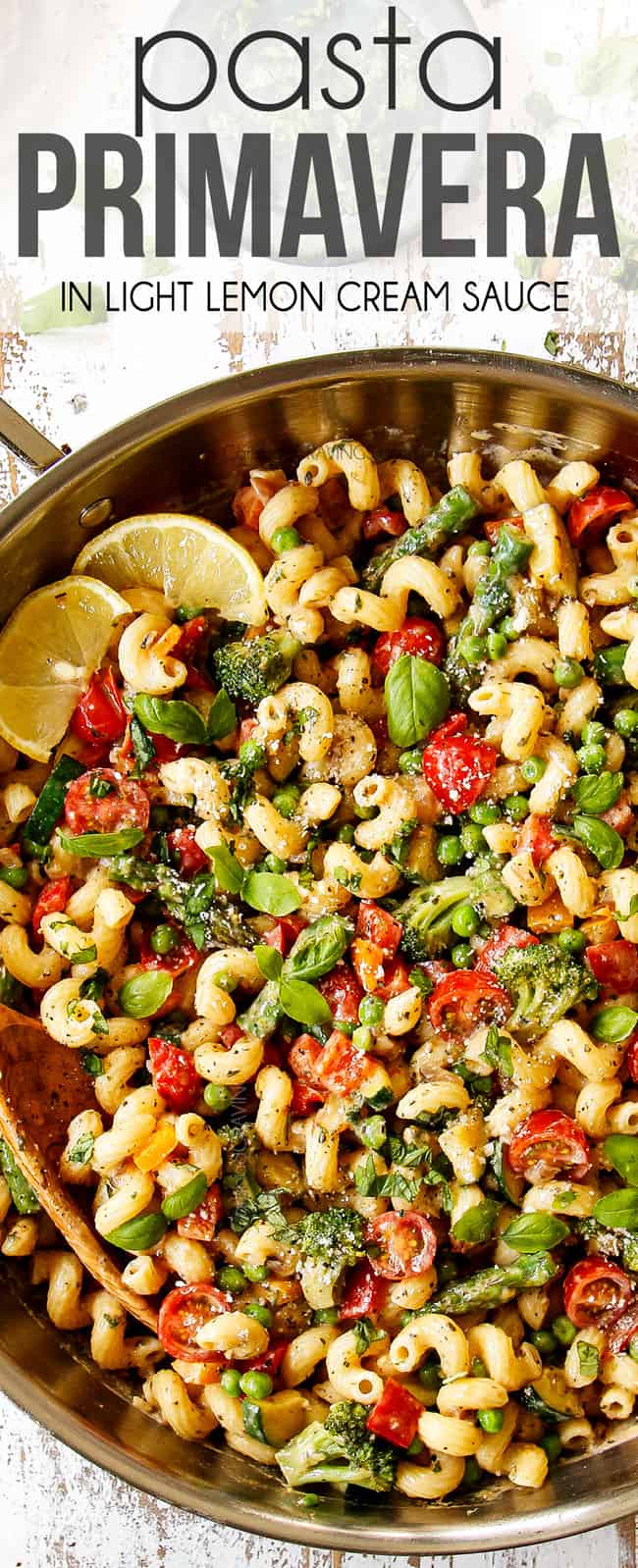
PIN THIS RECIPE TO SAVE FOR LATER
PASTA PRIMAVERA RECIPE
This pasta primavera recipe is a favorite at our house – not just in the spring/summer months but in the fall/winter too! It’s made with a few pantry staples and then whatever veggies you have on hand so you can make it year-round. Here’s why you’ll love this pasta primavera recipe:
- EASY 30-minute meal. The most time-consuming part of pasta primavera is chopping the veggies – but that can be done ahead of time or you can purchase chopped veggies. When it comes down to actually cooking, it’s less than 15 minutes! Simply sauté the veggies, simmer the sauce and combine.
- Versatile! Pasta primavera is so amazing because you can literarily make it differently every time depending on what veggies you add or whether or not you add protein. In the summer, load it up with zucchini, asparagus and tomatoes; the winter, load it up with carrots, Brussels sprouts and green beans or whatever is on sale that week. Pasta primavera is also a scrumptious way to use up kitchen-drawer veggies before they go bad.
- Pantry friendly. In addition to veggies, you will need chicken broth, heavy cream (or evaporated milk), cornstarch, lemon juice, Parmesan and dried seasonings. I always have these items on hand so it’s easy to whip up pasta primavera at a moment’s notice!
- Light cream sauce. The sauce is mesmerizing. It cradles the nooks and crannies of the vegetables, infusing them with bright citrus, zesty garlic, salty Parmesan and fresh basil.
- Nutritious. Pasta primavera is the tastiest way to eat veggies – and a large variety of them too!
What is Pasta Primavera?
Pasta primavera is an American pasta that boasts a wide variety of fresh, tender-crisp vegetables such as asparagus, tomatoes, broccoli, bell peppers, and zucchini. In fact, its Italian namesake primavera (pree-muh-VEHR-uh) means “springtime” and refers to the fresh spring vegetables in the dish.
Pasta primavera was originally made with spaghetti but today shorter pastas such as penne, campanelle, fussili are more popular. The pasta can be tossed in a variety of sauces from simple olive-oil with freshly grated Parmesan to a light, lemon cream sauce with Parmesan and fresh herbs.
Despite its namesake, pasta primavera is a groundbreaking American invention and not Italian. It shattered the culinary mold in 1975 when cooking with seasonal, fresh vegetables wasn’t the norm and instead canned soups and casseroles were commonplace. The combination of crisp-tender vegetables and pasta was so out-of-the-box at the time that it was hailed as “by far, the most talked-about dish in Manhattan” (Claiborne and Franey) and is considered one of the signature developments of American cuisine in the 1970s.
Who invented Pasta Primavera?
Pasta primavera is credited to New York chef and restaurant owner Sirio Maccioni who gives further credit to his wife. Maccioni was on a culinary assignment cooking for the Italian Baron at his summer home in Novia Scotia. In his memoir, Maccioni explains that after preparing many dishes of game and fish, the baron requested something different. At this request, he claims that his wife, Egidiana, threw pasta primavera together from ingredients on hand.
Maccioni brought the dish back to his famed French restaurant, Le Cirque, in New York City, where it became one of the most popular items on the menu. Soon, it was being served at restaurants all over. Its fame skyrocketed with a published recipe for pasta primavera in the New York Times a few years after its inception.
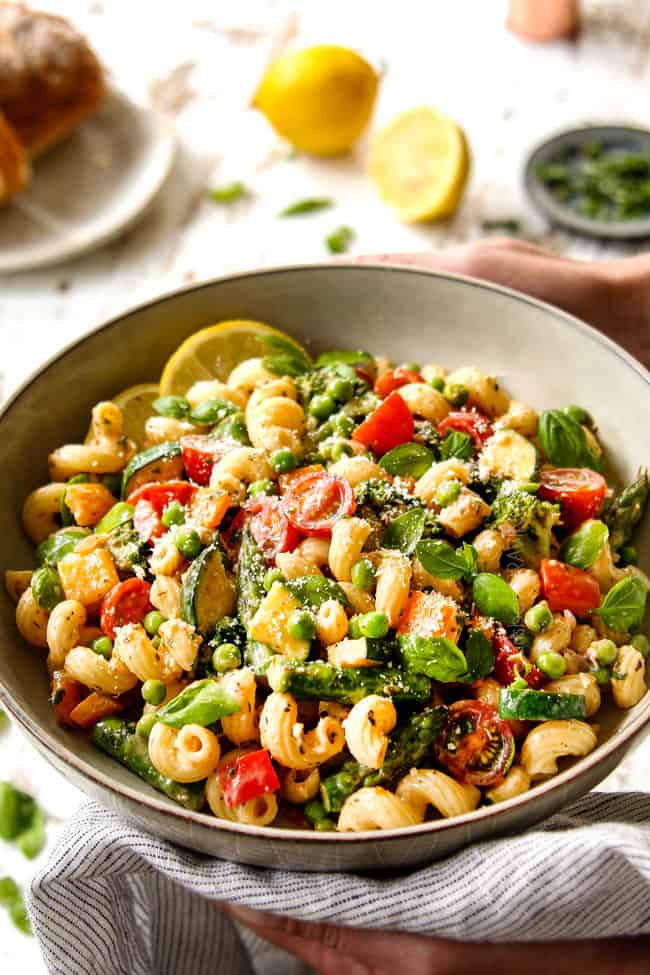
Is this authentic pasta primavera?
The original pasta primavera boasted a rich Alfredo-like sauce made with lots of butter, cream cheese, Parmesan, fresh tomato sauce and fresh vegetables. It was an arduous task suited for a professional kitchen calling for blanching the vegetables all separately in different pots as well as separate pots for sautéing the onions and garlic, a pot for the tomato sauce, a pot for the cream sauce and a pot for the pasta.
Today, pasta primavera can be made with just two pots (yay!) and the sauce is creamy yet light and brightened with fresh lemon juice. It is the best of yesterday’s innovative ideas and todays smart techniques and tastes.
What’s the difference between Pasta Primavera and Alfredo?
Both pasta primavera and Alfredo include a cream sauce but Alfredo sauce is much heavier with copious amounts of butter and more heavy cream. Pasta Alfredo can contain protein and veggies like my chicken Alfredo and shrimp Alfredo, but it often does not. Both pastas can be served with various pasta shapes.
Pasta primavera boasts a lighter cream sauce with a lemony notes that may or may or may not contain butter. The star of pasta primavera are the vegetables such as peas, carrots, broccoli, bell peppers, asparagus, mushrooms, zucchini, and tomatoes.
What Pasta Should I Use to Make Pasta Primavera?
Spaghetti has been replaced as the original primavera pasta in favor of shorter pastas that are easier to eat with a forkful of vegetables. Essentially, you can use any medium pasta that is roughly the same size as the vegetables. My favorite to use is cavatappi/ cellentani (pictured) because it cradles the sauce beautifully and is hearty enough to stand up to the vegetables. I also think pasta primavera would be especially tasty with tortellini – YUM! Just take care not to overcook the tortellini. Here are some more great pasta options:
- Campanelle
- Farfalle
- Fusilli
- Orecchiette
- Penne
- Mastacoli
- Gemelli
- Penne
Pasta types: you can use your favorite whole wheat pasta, lentil pasta, brown rice pasta, gluten free pasta, etc.
Low carb: go low carb with spiralized zucchini or spaghetti squash.
What Vegetables Are in Pasta Primavera?
Pasta primavera is made with a variety of spring vegetables such as asparagus and peas mixed with winter vegetables such as broccoli in order to achieve the best flavor and texture. For this pasta primavera recipe, I chose broccoli, summer squash, zucchini, asparagus, bell peppers, tomatoes and peas. This combination is absolutely delightful but you are welcome to you use any combination of vegetables, just try and use a variety of colorful, fresh vegetables for the best flavor and texture.
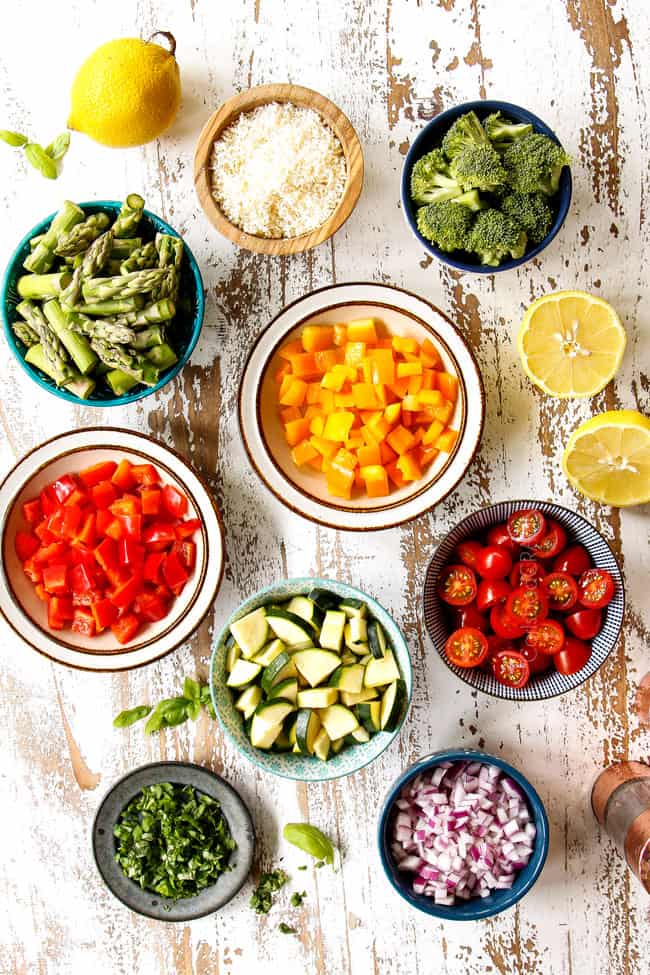
VEGETABLE INGREDIENT TIPS
- Broccoli: chop the broccoli florets into small pieces, roughly 1-inch so they cook in the same amount of time as the other ingredients.
- Zucchini and summer squash: when selecting zucchini and squash, look for smaller veggies because they are more flavorful. The only downside is smaller zucchini/squash don’t last as long so make sure to use them quickly. Look for zucchini/squash that are plump, firm and smooth without blemishes, soft spots or shriveled skin. Slice zucchini/squash on the thick side, at least ¼-inch because they cook very quickly.
- Asparagus: look for asparagus that are firm and straight and not limp and saggy. The asparagus should be bright green with a small amount of white towards the base. The tips should be compact and firm instead of loose and starting to spread or sprout. When asparagus is going bad, the tips are the first indicator – they will turn a very dark green and will become mushy when touched.
- Bell peppers: any color bell pepper will work in this recipe but I prefer red bell pepper. Red is the sweetest, with yellow and orange being the next sweetest. Green bell peppers have the strongest earthy flavor.
- Tomatoes: please use ripe cherry tomatoes because they are inherently sweeter than grape tomatoes. If you can’t find cherry, you may use grape.
- Peas: for speed and convenience, I’ve used petite frozen peas in this pasta primavera recipe. Frozen petite peas are picked and frozen at peak freshness. Please NEVER use mature peas – they are mushy! You are also welcome to use fresh peas and shell them yourself. For the best flavor, choose small peas, which are younger, sweeter, and have a better texture than mature peas. You will need 1 ½ pounds of peas in their pods yields to equal 1 ½ cups shelled peas.
- Red onion: please use red onion because its sweetness is divine with the citrus cream sauce.
- Basil: fresh is SO good, but you may use dried in a pinch. Use about 2 teaspoons, more or less to taste.
Can I Use Other Vegetables?
Yes! This pasta primavera recipe allows you to use any vegetables you would like. A few good options include:
- Corn: would be a super tasty addition. Cut the corn straight off of the cob and add to the skillet with the red onions.
- Mushrooms: give them a couple minutes head start before adding the onions and broccoli. If using mushrooms, don’t salt the vegetables until the very end because salt makes mushrooms cook slower and gives them a less desirable texture. Salting mushrooms near the end of cooking, however, results in more concentrated flavor.
- Carrots: slice very thinly and add with the red onions or slice into matchsticks and add with the zucchini.
- Eggplant: chop int ½-inch chunks and add with the red onion.
- Cauliflower: chop into small bite-size pieces and add with the red onion.
- Green beans: chop into 1 ½-inch pieces and add with the zucchini.
- Spinach: add spinach after you’ve combined the sauce with the veggies and warm for 1-2 minutes to wilt.
- Artichokes: are tender, slightly sweet and nutty. Purchase artichoke hearts in water NOT marinated. The marinated ones often have an acrid taste. Rinse the artichokes, chop and add with the zucchini.
Creamy Pasta Primavera
The original pasta primavera was made with a very heavy, rich sauce which overshadowed the vegetables. Today, pasta primavera is made with a light lemon cream sauce or just olive oil and Parmesan – you can guess which one I prefer! This creamy pasta primavera still tastes incredibly light and fresh because the sauce is thinner made with chicken broth and heavy cream and not loads of butter and cream. It’s deliciously flavorful infused with garlic, zesty Parmesan, basil, oregano, parsley, thyme, and a splash of lemon – it tastes like vibrant summer!
CREAMY SAUCE INGREDIENTS
- Parmesan cheese: infuses the sauce with its fantastic salty, nuttiness. For best results, use ONLY freshly grated Parmesan cheese. It is much more flavorful and melts into silky oblivion unlike powdered or pre-shredded cheese.
- Chicken broth: is more flavorful than just milk or cream. Make sure you use low sodium broth so we can control the salt. You may substitute with vegetable broth but I don’t find it as flavorful.
- Heavy cream: is called “heavy whipping cream” at your grocery store.
- Cornstarch: helps thicken the sauce without having to make a roux so it’s beautifully silky and not runny. The cornstarch also allows us to use mostly chicken broth instead of all heavy cream.
- Olive oil: use extra virgin olive oil for superior flavor.
- Garlic: I use 4 cloves garlic but feel free to use less if you prefer. You may also use 1 teaspoon garlic powder – but the real stuff is so much better!
- Red chili pepper flakes: enliven the pasta primavera with a little kick. You can also add red pepper to individual servings.
- Seasonings: this creamy pasta primavera is seasoned to perfection with parsley, oregano, thyme, salt, and pepper. Use more or less to taste.

CAN I SUBSTITUTE THE HEAVY CREAM?
The heavy cream + chicken broth + cornstarch elevates this creamy pasta primavera to restaurant delicious without all the calories of using all heavy cream. If you’re trying to save more calories, you can substitute the heavy cream with 1 cup milk whisked with 2 teaspoons cornstarch but take care only to gently simmer and never boil. You may also use evaporated milk in place of heavy cream.
Can I add cream cheese?
If you would like extra decadence, stir in some warmed, almost melted cream cheese to the sauce, just like the original from the 1970s!
Can I Add Chicken or Shrimp to This Recipe?
Absolutely! You can add any protein to this pasta primavera such as rotisserie chicken, leftover chicken, grilled chicken, Italian sausage or sautéed shrimp. If you add protein, you will need to add less vegetables or they’re won’t be enough sauce OR increase the sauce portion of the recipe.
HOW TO MAKE PASTA PRIMAVERA
- Cook pasta. Cook pasta in salted water according to package directions until al dente. Reserve ½ cup pasta water before draining pasta. Toss drained pasta with a drizzle of olive oil to keep it from sticking. Set aside.
- Cook vegetables. While the pasta is cooking, sauté red onions and broccoli in a deep skillet/saucepan for 3 minutes. Add squash, zucchini, asparagus, bell peppers, tomatoes, and season with ¼ teaspoon salt. Sauté 2 minutes or until veggies are tender-crisp. Transfer veggies to a large bowl; set aside.
- Make cream sauce. To the now empty skillet, sauté garlic and red pepper flakes for 30 seconds. Add heavy cream. Whisk chicken broth with cornstarch and add to skillet along with oregano, parsley, thyme, and ¼ teaspoon salt. Bring the sauce to a simmer; simmer until lightly thickened, approx. 3-5 minutes. Reduce heat to low and stir in ½ cup Parmesan until melted followed by lemon juice. Add peas and warm through.

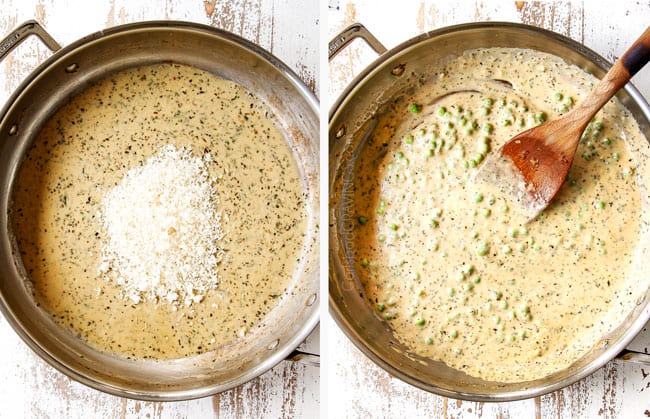
- Combine. Add vegetables back to the sauce along with pasta and chopped basil; toss to combine. Add additional reserved pasta if needed to thin to desired consistency (I didn’t use any).
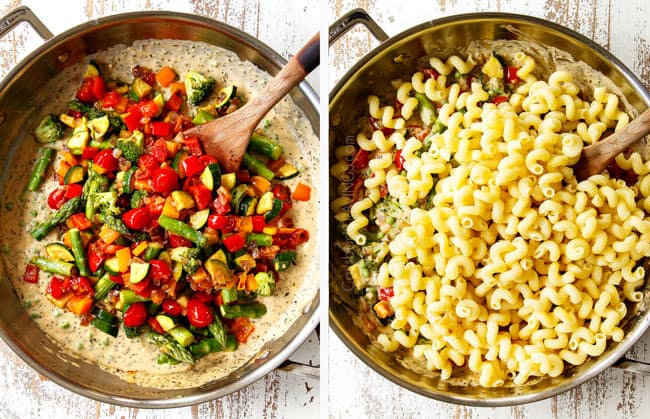
- Season to taste. Taste and season with freshly cracked salt and pepper to taste and additional lemon juice if desired. Garnish with additional ¼ cup Parmesan.

TIPS FOR PASTA primavera
This pasta primavera recipe is pretty straightforward, but here are a few tips and tricks for fool proof pasta every time:
- No 1 Tip – don’t overcook your veggies. Nothing will ruin pasta primavera like soft or worse, mushy vegetables. The vegetables should be tender crisp/al dente- and not soft. Use a timer so you don’t overcook them.
- Don’t overcook pasta. I recommend testing your pasta about 2 or 3 minutes before the box recommends – pasta should be al dente– meaning it should still be a little firm in the center/ have a “bite” to it.
- Use a large enough pot. The vegetables plus the pasta all combine in one dish so you’ll need a deep saucepan or braiser with plenty of wiggle room. If you don’t own either one of these, use a Dutch oven. Alternatively, you can cook the vegetables and sauce in a skillet and combine everything together in the large pasta pot.
- Use a variety of vegetables. The vegetables in this recipe are just a guide. If adding your own veggies, make sure to use a healthy variety of texture, color, and flavor.
- Vegetable shortcut. Select a variety pack of stir-fried veggies and add to them as needed. You may need to chop some of the vegetables down so they cook in the same amount of time.
- Scale veggies if adding protein. If you add protein, you will need to add less vegetables or they’re won’t be enough sauce OR increase the sauce portion of the recipe.
- Fresh Parmesan. Use ONLY freshly grated Parmesan cheese. It is much more flavorful and melts into silky oblivion unlike powdered or pre-shredded cheese.
- Use additional Parmesan. Parmesan adds fantastic flavor and should not only be added to the sauce but use plenty as a garnish as well.
- Salt pasta water. You should always salt your pasta water – it is the one chance you have for the flavor to penetrate the pasta and enhance the flavor – you can taste the difference. Use 1 tablespoon salt for 6 quarts of water.
- Reserve water. It is always a good idea to reserve some of the pasta water before draining the pasta. The starchy, flavorful water can be stirred into the sauce to help reach desired consistency.
- Thin sauce if needed. If the sauce becomes too thick, simply stir in a little reserved pasta water until it reaches desired consistency.
- Bursting tomatoes. You can cook the tomatoes more or less depending on how “burst” you want them. As written, the tomatoes will be soft and some will be bursting. If you don’t want as tender of tomatoes, add the tomatoes with the heavy cream instead of the zucchini.
- Add lemon juice to taste. 2 tablespoons lemon juice adds a nice lemony taste. You can use more or less depending on how citrusy you would like your pasta primavera.
PASTA PRIMAVERA RECIPE VARIATIONS
- Pasta primavera with chicken: add shredded rotisserie chicken, Greek chicken, lemon basil chicken or simple baked or poached chicken.
- Pasta primavera with sausage: mild ground Italian sausage would be amazing. You could also use turkey sausage or chicken sausage just make sure to season with Italian seasonings – every element should be independently seasoned. You can also use Italian seasoned sliced, fully cooked chicken sausage.
- Pasta primavera with shrimp: roasted shrimp or butter garlic shrimp would be fabulous.
- Pasta primavera with bacon: sizzle up thick-cut bacon and use the drippings to sauté the vegetables in. Add chopped bacon to the pasta at the very end of cooking.
- Pasta primavera with roasted vegetables: instead of sautéing the veggies, you can use your favorite roasted veggies such as roasted broccoli, roasted cauliflower, roasted asparagus, roasted Brussels sprouts, roasted root vegetables.
- Pasta primavera with sun-dried tomatoes: purchase sun-dried tomatoes in oil, not water. They are usually located near the olives or pickles at your grocery store. Use the oil in the jar instead of the olive oil. Rinse the tomatoes, pat dry, chop and sauté with the zucchini.
- Cheesy pasta primavera: add freshly shredded mozzarella, Fontina, Gouda, or even goat cheese to the sauce for extra creamy decadence and to mix up the flavor profile.
- Spicy pasta primavera: amp up the heat with additional red pepper flakes. I always add at least ¼ teaspoon red pepper flakes but if you really like a kick, add ½ teaspoon. You can also add additional red pepper flakes to individual servings to keep the pasta family friendly.
- Gluten free pasta primavera: use your favorite gluten free pasta. The rest of the ingredients are gluten free.
- Pasta primavera without cream: skip the heavy cream, chicken broth and cornstarch and instead sauté the garlic and seasonings in plenty of olive oil. Add additional olive oil as needed to the pasta to moisten. Add freshly grated Parmesan directly to the pasta.
- Vegetarian pasta primavera: substitute the chicken broth for vegetable broth.
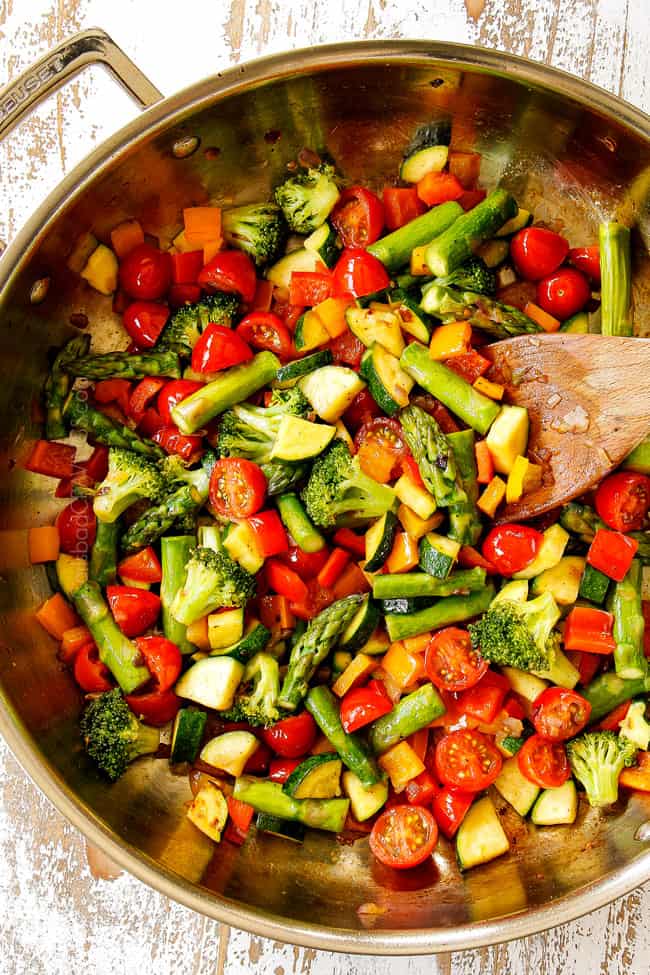
HOW TO STORE AND REHEAT Creamy PASTA primavera
This pasta primavera recipe reheats well so you can enjoy leftovers for days! Just be take care your pasta is cooked al dente, especially if you are going to be reheating.
- Storage: transfer pasta primavera to an airtight container and store in the refrigerator for up to five days.
- Microwave: transfer to a microwave safe dish and add splash of milk or water. Microwave for one minute, stir, then continue to heat at 30 second intervals until warmed through.
- Stove: For larger portions, reheat pasta on the stove over medium-low, stirring frequently until warmed through. You may need to add a splash of milk to thin the sauce as it will have thickened in the refrigerator.
CAN I FREEZE PASTA PRIMAVERA RECIPE?
I do not recommend freezing this pasta primavera recipe because the creamy sauce can break and become a funny texture. Some of the vegetables will also become mushy when frozen and thawed. If you want to try freezing, use evaporated milk instead of heavy cream and omit the Parmesan.
HOW TO MAKE PASTA PRIMAVERA RECIPE AHEAD
To make ahead:
You can make the pasta primavera recipe 100% ahead of time and gently warm (see instructions) or prepare elements in advance so it can come together super quickly at dinner time. That being said, it already is a super quick meal! If you know you are reheating, take extra your vegetables are crisp-tender and the pasta is cooked al dente – testing the pasta a couple minutes before the package directions specify.
To prep ahead:
- Pasta: cook the pasta al dente, drain with cool water and toss with a drizzle of oil to prevent it from sticking together. Store in an airtight container in the refrigerator until ready to use.
- Vegetables: chop and store the red onions and broccoli together and the rest of the ingredients together in a separate airtight container.
- Aromatics: mince the garlic, and chop the basil.
- Cheese: grate the Parmesan.
WHAT TO SERVE WITH PASTA PRIMAVERA?
We love this pasta primavera recipe with a big green salad, crusty bread and/or any of the following:
- Protein: pasta primavera can be a main dish win or serve it alongside grilled chicken, lemon basil chicken, Greek chicken, marinated flank steak or lemon garlic salmon.
- Bread: garlic bread, dinner rolls, garlic Parmesan butter breadsticks or pesto pull apart bread.
- Salad: Although this pasta primavera recipe is bursting with veggies, it still pars well with a fresh, crunchy salad such as wedge salad, apple Salad, pear salad, or strawberry salad.
- Fruit: Bright, fresh fruit is a must either in the form of fresh grapes, melon, etc. or in fruit salad form. We love fruit salad with honey lime vinaigrette, watermelon salad, pina colada fruit salad and berry salad in honey mascarpone.
IS PASTA primavera HEALTHY?
Pasta primavera is bursting with vegetables and therefore bursting with vitamins and minerals. Some of the health benefits of vegetables in pasta primavera include:
- Vitamin K: is important for maintaining bone health and wound healing. It helps produce four of the 13 proteins needed for blood clotting.
- Vitamin A: helps support eye health, cell division, immune system, and reproduction. Vitamin A also helps the heart, lungs, kidneys, and other organs function properly. Vitamin A also has antioxidant properties which might protect your cells against the effects of free radicals, reducing the risk of heart disease, cancer and other diseases.
- Vitamin C: is a powerful antioxidant that protects the body from damaging free radicals and necessary for the growth, development and repair of all body tissues. It builds collagen, which forms body tissue and bone, and helps cuts and wounds heal.
- Vitamin B-2: helps support cellular functions that give you energy by break down carbohydrates, proteins and fats to produce energy. It also helps your body build red blood cells which allows oxygen to be used by the body.
- Iron: is needed to carry oxygen to from the lungs to all parts of the body. Your body also needs iron to make some hormones and keep your hair, skin and nails healthy. If you do not have enough iron, you will become groggy and weak.
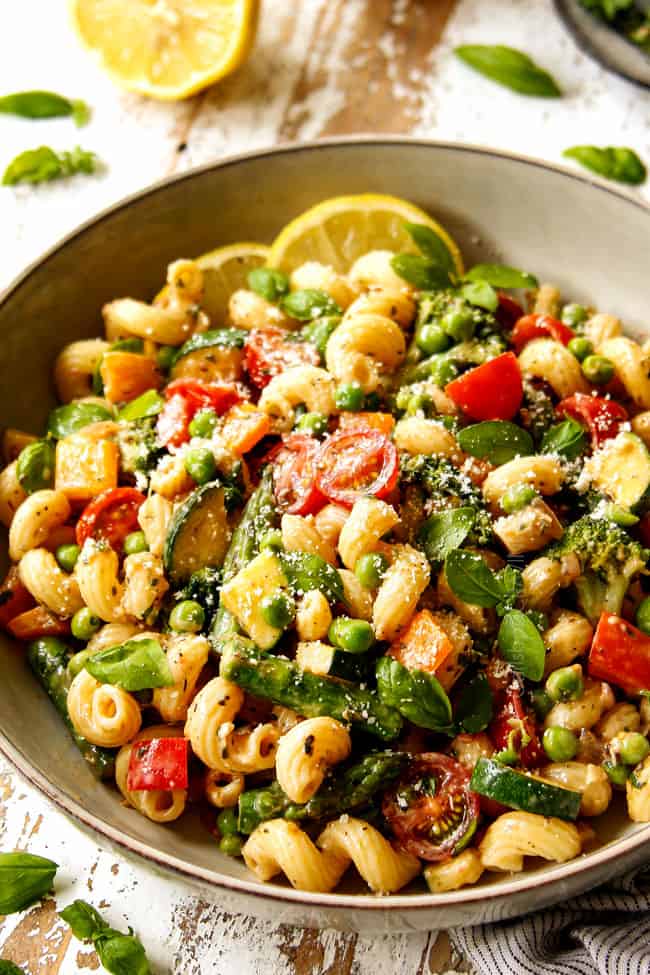
Want to try this Pasta Primavera RECIPE?
Pin it to your Pasta, Dinner or 30-minute meal Board to SAVE for later!
Find me on Pinterest for more great recipes! I am always pinning :)!
©Carlsbad Cravings by CarlsbadCravings.com
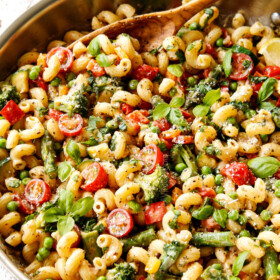
Pasta Primavera
Save This Recipe To Your Recipe Box
You can now create an account on our site and save your favorite recipes all in one place!
Ingredients
- 12 oz. cavatappi or other short pasta such as penne, fusilli, or orecchiette
- 4 tablespoons extra virgin olive oil divided
- 1/2 medium red onion chopped
- 2 cups broccoli florets cut into 1-inch pieces
- 1 medium yellow squash sliced and quartered
- 1 medium zucchini sliced and quartered
- 8 oz asparagus trimmed, cut into 1 1/2-inch pieces
- 1 medium red bell pepper chopped
- 1 1 /2 cup cherry tomatoes halved
- salt and pepper
- 4 cloves garlic minced
- 1/4 teaspoon red pepper flakes
- 1 cup heavy cream (may sub evaporated milk)
- 1 1/2 cups chicken broth
- 1 tablespoon cornstarch
- 1 1/2 tsp EACH dried oregano, dried parsley
- 1/2 teaspoon dried thyme
- 2 tablespoons lemon juice
- 3/4 cup freshly grated Parmesan cheese divided
- 1 1/2 cups frozen petite peas thawed
- 1/4 cup fresh basil chopped
Instructions
- Cook pasta in salted water according to package directions. Reserve ½ cup pasta water before draining.
- Meanwhile, heat 3 tablespoons olive oil in a large, deep saucepan/skillet over medium-high heat. Add red onions and broccoli and sauté 3 minutes.
- Add squash, zucchini, asparagus, bell peppers, tomatoes, and season with ¼ teaspoon salt and ¼ teaspoon pepper. Sauté 2 minutes or until veggies are tender-crisp. Transfer veggies to a large bowl; set aside.
- To the now empty skillet, heat 1 tablespoon olive oil over medium heat. Add garlic and red pepper flakes and sauté 30 seconds. Turn heat to low and add heavy cream. Whisk chicken broth with cornstarch and add to skillet along with oregano, parsley, thyme, and ¼ teaspoon salt.
- Bring the sauce to a simmer; simmer until thickened, approx. 3-5 minutes. Reduce heat to low and stir in ½ cup Parmesan until melted followed by lemon juice. Add peas and fresh basil and warm through.
- Stir vegetables into sauce followed by pasta, adding additional reserved pasta water a little at a time if needed to thin to desired consistency (I didn’t use any). Taste and season with freshly cracked salt and pepper to taste. Garnish with additional ¼ cup Parmesan – or more!
Notes
TIPS and Tricks
This pasta primavera recipe is pretty straightforward, but here are a few tips and tricks for fool proof pasta every time:- No 1 Tip – don’t overcook your veggies. Nothing will ruin pasta primavera like soft or worse, mushy vegetables. The vegetables should be tender crisp/al dente- and not soft. Use a timer so you don’t overcook them.
- Don’t overcook pasta. I recommend testing your pasta about 2 or 3 minutes before the box recommends – pasta should be al dente– meaning it should still be a little firm in the center/ have a “bite” to it.
- Use a large enough pot. The vegetables plus the pasta all combine in one dish so you’ll need a deep saucepan or braiser with plenty of wiggle room. If you don’t own either one of these, use a Dutch oven. Alternatively, you can cook the vegetables and sauce in a skillet and combine everything together in the large pasta pot.
- Use a variety of vegetables. The vegetables in this recipe are just a guide. If adding your own veggies, make sure to use a healthy variety of texture, color, and flavor. See post for how to add different veggies.
- Vegetable shortcut. Select a variety pack of stir-fried veggies and add to them as needed. You may need to chop some of the vegetables down so they cook in the same amount of time.
- Scale veggies if adding protein. If you add protein, you will need to add less vegetables or they’re won’t be enough sauce OR increase the sauce portion of the recipe. See post for protein variations.
- Fresh Parmesan. Use ONLY freshly grated Parmesan cheese. It is much more flavorful and melts into silky oblivion unlike powdered or pre-shredded cheese.
- Bursting tomatoes. You can cook the tomatoes more or less depending on how “burst” you want them. As written, the tomatoes will be soft and some will be bursting. If you don’t want as tender of tomatoes, add the tomatoes with the heavy cream instead of the zucchini.
- Add lemon juice to taste. 2 tablespoons lemon juice adds a nice lemony taste. You can use more or less depending on how citrusy you would like your pasta primavera.
HOW TO STORE AND REHEAT
This pasta primavera recipe reheats well so you can enjoy leftovers for days! Just be take care your pasta is cooked al dente, especially if you are going to be reheating.- Storage: transfer pasta primavera to an airtight container and store in the refrigerator for up to five days.
- Microwave: transfer to a microwave safe dish and add splash of milk or water. Microwave for one minute, stir, then continue to heat at 30 second intervals until warmed through.
- Stove: For larger portions, reheat pasta on the stove over medium-low, stirring frequently until warmed through. You may need to add a splash of milk to thin the sauce as it will have thickened in the refrigerator.
To prep ahead:
- Pasta: cook the pasta al dente, drain with cool water and toss with a drizzle of oil to prevent it from sticking together. Store in an airtight container in the refrigerator until ready to use.
- Vegetables: chop and store the red onions and broccoli together and the rest of the ingredients together in a separate airtight container.
- Aromatics: mince the garlic, and chop the basil.
- Cheese: grate the Parmesan.

Did You Make This Recipe?
Tag @CarlsbadCravings and Use #CarlsbadCravngs
Leave a Review, I Always Love Hearing From You!
Carlsbad Cravings© Original
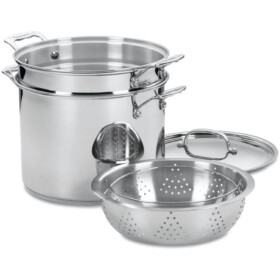


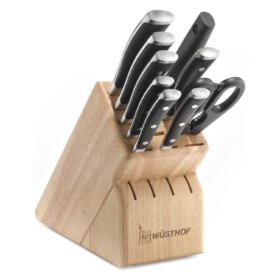
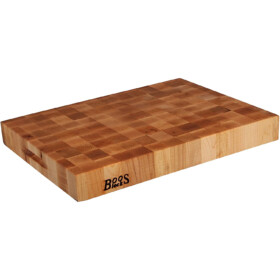

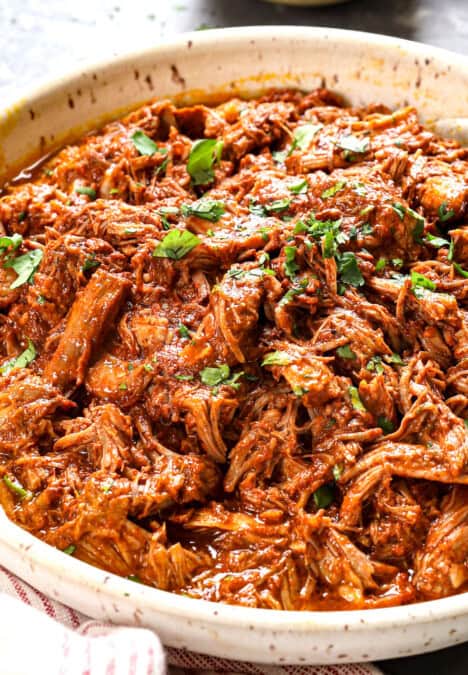
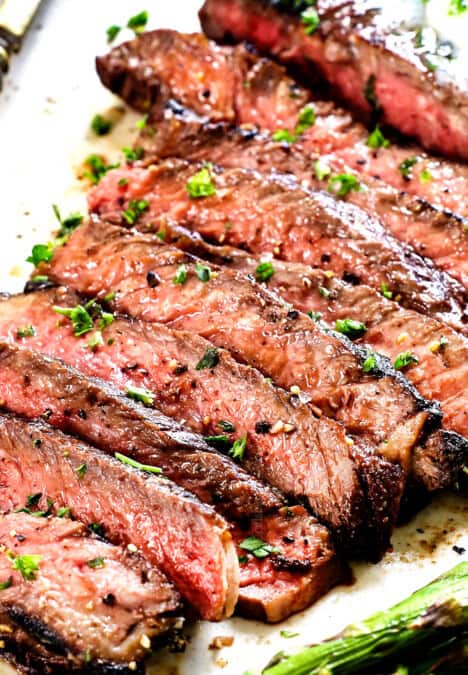
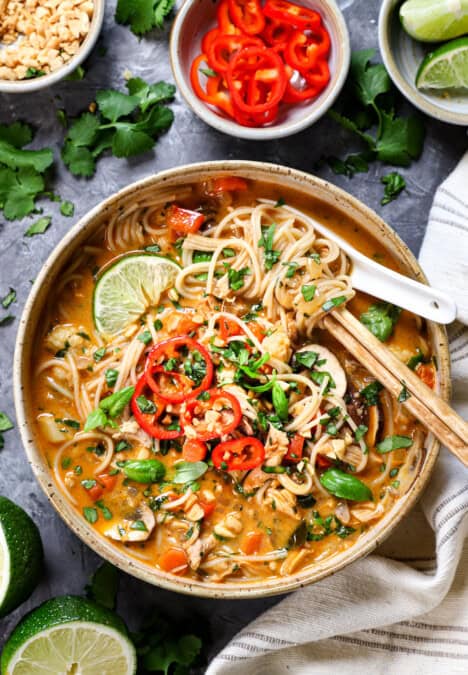
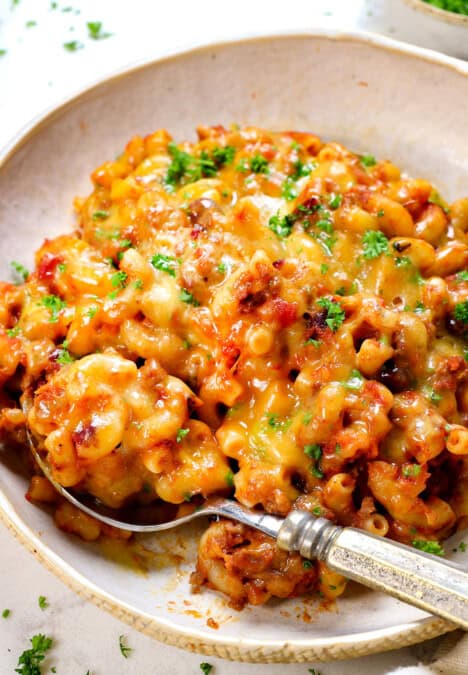

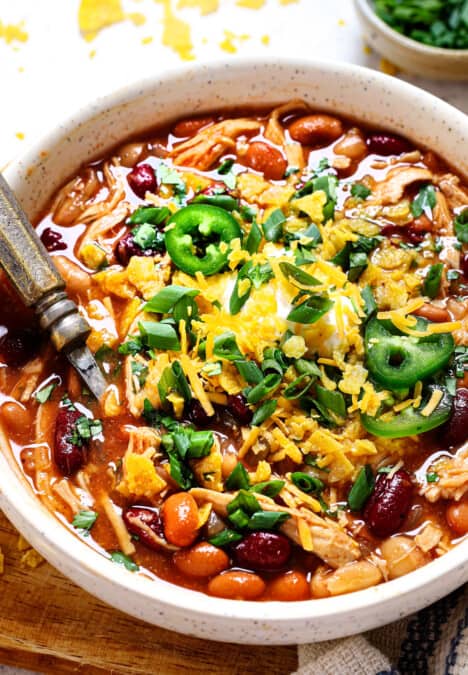























GrammaSue says
Hi Jen! This was amazing!!! I did have to leave out the zucchini (only bc my husband doesn’t like it cut up bc it gets too soft too quickly-but I love it). What is so unique about this dish is that it is so versatile–you can add any veggie or protein that works for you. Even cheese-parm, goat, fontina, etc. so yummy. Thanks so much for posting!
Jen says
That’s awesome you made it already! I’m so happy you loved it, thank you!
Pascale says
Do you have any non dairy alternative for this recipe? Would coconut cream work?
Jen says
Hi Pascale, you could certainly try coconut milk and just know there would be a slight coconut taste. Otherwise, you can make it non-creamy and omit chicken broth and heavy cream and toss the pasta in additional olive oil.
GiGi says
This was wonderful!!! I used entire box of pasta (16 oz.) and subbed evaporated milk for heavy cream. It was delicious and we have tons of leftovers for the week – thanks Jennifer!
Jen says
You’re so welcome Gigi! I’m thrilled you loved it so much and were successfully able to sub evaporated milk!
Paddy says
Hi Jen,
Another great recipe!!!! Absolutely delicious!
Thank you for always giving us such great meals
-Paddy
Jen says
Thank you so much for your awesome comment Paddy! I’m so happy you loved it!
Cindy says
I can’t wait to try this colorful dish. As always your descriptions make my mouth water plus your recipe photos are so deliciously & beautifully presented. Thank you for the nutrient info too it’s always good to know the the bare bones reason for eating in the first place. Always look forward to reading your posts you put so much into each one. Thanks also for doing all the trial and error to optimize the dining experience! God bless you!
Jen says
Thank you so much for your thoughtful comment Cindy! I love hearing you look forward to my posts and find them helpful! I hope this pasta primavera recipe is a new favorite!
Pattie says
My daughter can’t have dairy how could I modify the pasta primavera it looks so good and we love your recipes
Jen says
Hi Pattie! You can make it a non-dairy version by omitting the heavy cream and adding additional olive oil. Hope that helps!
Andrea calaway says
Oh my goodness!!!!! Sooooo yummy! I did the evaporated milk substitution, with lemon basil and !!!! Oh gosh how I love your website for recipes!
I have been flowing your site now for almost 3 years now and I have never made recipes with such ease flexibility! I love the fact that I almost always have the basics of what you use on hand! I also have not come across a dish of ours I haven’t LOVED! I ALWAYS get compliments when I make your dishes! Thank you, Thank you!!!
Jen says
I’m so happy you loved the pasta primavera, thanks Andrea! Thank you especially for your super thoughtful comment! I’m honored you’ve been following me for so long and are loving my recipes!
Erika says
This is my third recipe of yours to make and they have all been fantastic. I haven’t had to run to the store for anything either! I had fresh basil that I had flash frozen last fall, and I basically cleared my veggie drawer for this perfection. You actually got me to time my veggie cooking, which no recipe gets me to do. Thank you so much for your well thought out recipes, with perfected side notes. Cheers
Jen says
Welcome to my site Erika! I’m so pleased you have enjoyed all of the recipes you’ve tried so far, including this one! That’s great you haven’t had to run to the store – that’s exactly how I like to cook! I hope you enjoy exploring my site and hopefully discovering many new favorites!
Carrie says
If I cook the pasta and veggies in the morning (cooking for 30 kiddos)… can I re-warm in the oven or a serving dish?
Jen says
That is amazing, lucky kids! It would be best to rewarm on the stove so you can add additional milk/broth to “saucy” it up. If that’s not a possibility, I would add extra sauce OR slightly less pasta so it doesn’t dry out, add to baking dishes, and cover with cheese, then bake in the morning to reheat. Hope that helps!